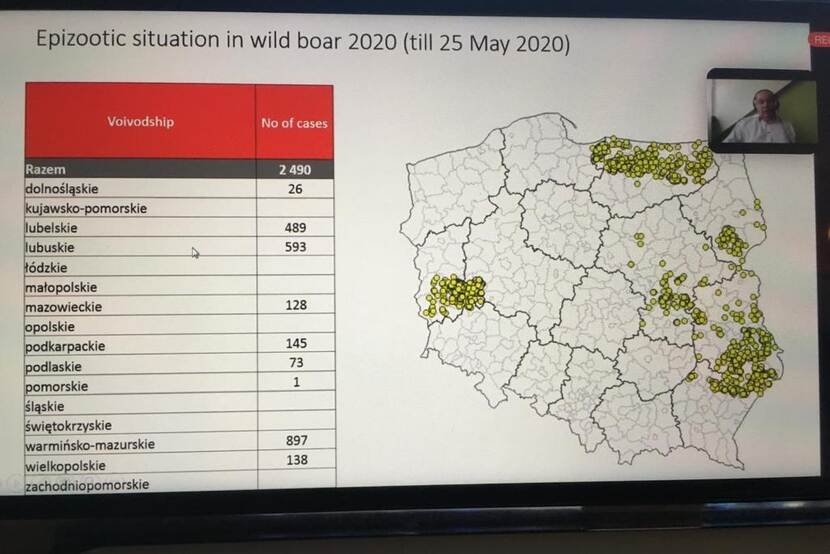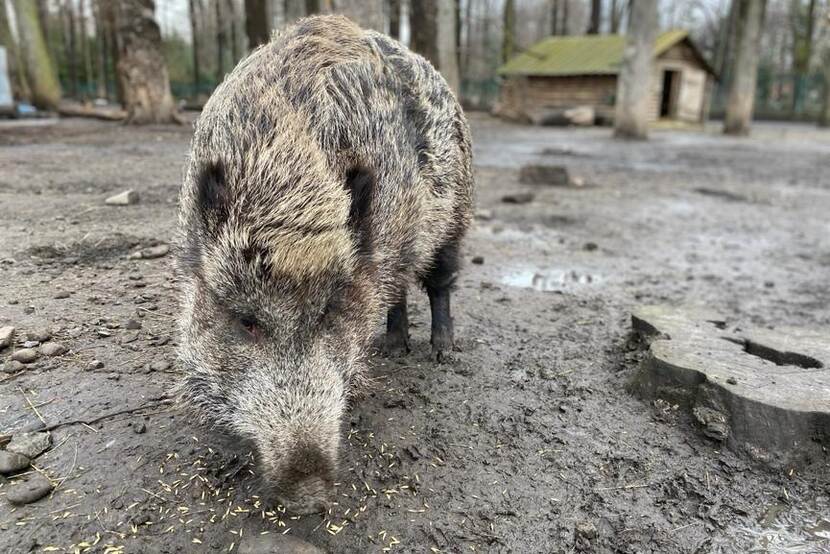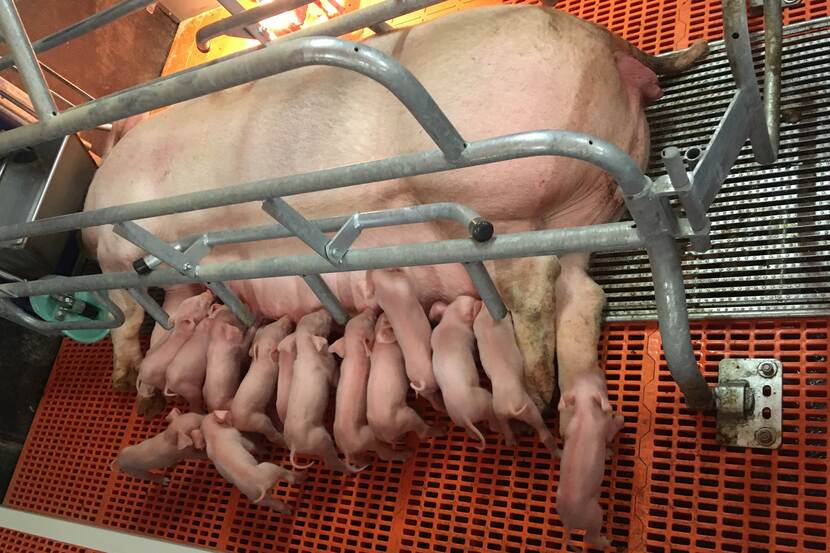Challenges of ASF control in Poland – Embassy’s webinar
For the pig farmers African swine fever poses a great threat and since the disease is present in the wildlife, the biggest question is how to protect your farm against introduction of the virus, which will lead to culling all the pigs and imposing severe ASF trade restrictions. However, also the eradication of the disease in the wild boar population remains a challenge, since their number seems to be underestimated. Also in order to reduce the presence of the virus in the environment, a special attention shall be given to establishing good cooperation between the veterinary service, forestry service and the hunters.

African Swine Fever (ASF) is a deadly disease of suidae species. It is present in the wildlife and can easily be transmitted to the pig farms, where it poses a great risk to the pig production, as even with one infected pig the whole herd has to be culled. Therefore, although the disease is not harmful to humans, it caused great economical losses.
In Poland the disease first appeared in 2014 in wild boar population in the east of Poland, at the border with Belorussia. Since then it caused a deaths of numerous wild boars and affected a number of pig farms in a large territory of the country. Therefore, Poland has already a vast experience in controlling the disease.
It can be noticed that when disease is found in wildlife, the pig farms are at immediate threat. Last year we could observe the worrying infection detected in the west of Poland, followed by 2 ASF outbreaks on large pig farms this year. The spread of the disease close to the German border calls for more attention from the Dutch pig industry to hear about the challenges faced by Polish authorities and pig farmers operating in Poland.
On 27 May 2020 the Embassy of the Kingdom of the Netherland and the Netherlands-Polish Chamber of Commerce organized the webinar on the African Swine Fever (ASF) situation in Poland, both in wild boars and in pig sector.
How is Poland doing presently with controlling the disease? What can the Dutch pig industry learn from the Polish experience? Our experts gave an overview from two perspectives: wild boar management and pig sector challenges.
- Krzysztof Jazdzewski, ASF expert, member of the EU Veterinary Emergency Team for ASF, with experience in Polish Veterinary Service, discussed ASF eradication in wild boars and challenges to Polish authorities;
- Bas Zegers, the pig farmer operating in the west of Poland in the area covered by the ASF restrictions (Part II area as defined in the EU provisions) talked about pig movement restrictions when ASF is confirmed in pig heard and protection of pig farms against African swine fever.
ASF in wild boars
In Poland massive infection of wild boars can be observed, which is significantly different from the countries where the disease was contained. In Poland ASF spreads slowly but constantly.

Until 25 May 2020, 2 490 ASF positive cases were confirmed in wild boars, which already exceeds the number of all confirmed cases in 2019 (2 477). The increased number of detected infected wild boars is associated with the new financial incentives introduced by the Polish government in 2018 for reporting dead animals, as well as with the increasing infection area (currently ASF restricted zones cover 45,67% of Polish territory).
Polish authorities introduced several measured to control the disease, like reducing wild boar population (intensified hunting, targeted hunting of female wild boars) and removal of the infected material from the environment, creating of specialized search group, fencing and trapping (whole western cluster to be fenced – 700 km2), introduction of new, advanced biosecurity rules for farms (voluntary), setting up groups of targeted silent shooting.
However, still the challenges remain. The main problem is the removal of dead animal corpses from the environment in order to reduce viral load of the virus by dead wild boar searching. The corpses are in different state of decay and often in areas with difficult accessibility (swamps etc.). Therefore it is important to cooperate between veterinary service, forestry service and hunters.
The other obstacle is the underestimated number of wild boar population. In the hunting season 2019/2020 the estimated population was 67 290, with 165 481 animals to be hunted in order to control the population, while the final number of obtained animals was 373 300. Since the statistics is based only on estimation, it does not give the correct numbers to design sanitary shooting.
Yet another issue are the costs borne by the state. Sanitary shooting is financed from the state budget, with certain amount for all hunted wild boars. But also laboratory tests on both pigs and wild boars are covered by the state – in 2014-2020 (until 18 April) 247 399 tests were performed on wild boars and 1 869 963 tests on pigs!
At the same time the farmers are concerned about wild boar testing procedure. Currently, shot wild boar carcasses are maintained in coolers pending the results of ASF testing and if found negative can be consumed by the hunter, as an incentive to perform shooting. However, farmers request to destroy all carcasses after shooting, without keeping them in the coolers, to minimize the risk of ASF spread.
The presentation about ASF situation in wild boars is published HERE.
ASF in pigs
Once ASF is detected in a country, regionalization/zoning according to the EU rules is established. Three demarcated parts correspond to 3 level of risk:
- Part III area - presence of ASF in domestic pigs and wild boars
- Part II area - presence of ASF only in wild boars; free from ASF in domestic pigs
- Part I area - no disease; higher risk due to proximity of ASF in wild boar

Bas Zegers’ farm was started in 1997 in the west of Poland. In 2019 the first ASF infected wild boar was found in Lubuskie region, 7,5 km from the farm. Since the farm is located in the middle of the forest, there is increased risk of ASF infection. Presently, due to the regionalization, the farm is included in Part II area, with the requirement of pig testing before each movement. In the production cycle every week 30-60 pigs are tested.
In March and April 2020, primary and secondary outbreaks of ASF on pig farms were noted in the region. In accordance with the EU rules, Part III area was established, 1,5 km from Bas Zegers’ farm, where pig movements restrictions are more severe, as they can be moved only within that area or to a designated slaughterhouse.
Due to the high prevalence of the virus in the wildlife, the biggest challenge is to protect the farm against the disease. Unfortunately, there are many risk factors and no fast solutions. Certain crops (like maize) might attract the wild boars and even fencing is not a solid barrier. The most important is to separate pigs from the environment – it should be normal biosecurity rule applied every day. However, constant threat of ASF is exhaustive, people can get tired with strict biosecurity rules. Nevertheless, since it is not only wildlife but also human factor should be taken into account, discipline and good biosecurity is the most important.
Bas Zegers pays a great attention to biosecurity of his workers. They cannot work on other farms, not to be involved in hunting, going to forest. The employees have to shower before changing to company clothes – only then they ae allowed to enter the pigs. The strict rules apply also to veterinary inspectors visiting his farm – they need to sign a statement that they had no contact with pig or wild boars 48h prior to entering the farm.
It was also noticed that ASF restrictions, which are established at the EU level, create many difficulties for farmers who have their production sites in Part III, Part II or Part I areas. Therefore, the EU member states shall cooperate while developing this rules to make pig trade safe but at the same time to allow keeping the pig production in the affected areas.
LAN-WAR own report- AG